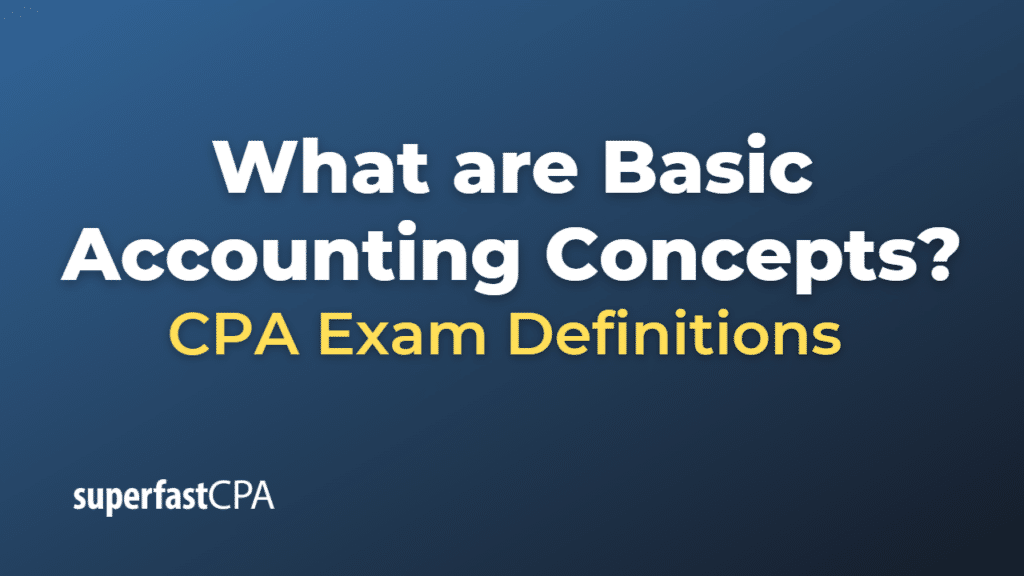Basic Accounting Concepts
Basic accounting concepts are the fundamental principles and guidelines that govern the practice of accounting. These concepts provide a framework for recording, reporting, and interpreting financial transactions and ensure consistency, reliability, and comparability of financial information across different businesses and time periods. Some of the most important basic accounting concepts include:
- Accrual basis accounting: This concept states that financial transactions should be recorded when they are incurred, rather than when cash is exchanged. This approach provides a more accurate picture of a company’s financial position and performance.
- Economic entity assumption: This concept assumes that a business is a separate economic entity from its owners or shareholders. This means that the financial activities of the business should be recorded and reported separately from the personal financial activities of its owners.
- Monetary unit assumption: This concept states that financial transactions and events should be measured and reported in a common currency. This allows for a consistent and comparable presentation of financial information.
- Time period assumption: This concept assumes that a business’s financial activities can be divided into distinct time periods, such as months, quarters, or years. This allows for the periodic reporting of financial information, which is essential for decision-making and performance evaluation.
- Cost principle: According to this concept, assets should be recorded at their historical cost, which is the amount paid to acquire the asset. This principle emphasizes objectivity and verifiability in accounting.
- Revenue recognition principle: This concept states that revenue should be recognized when it is earned and realized or realizable, regardless of when cash is received. This ensures that financial statements reflect the company’s financial performance accurately.
- Matching principle: This concept requires that expenses be matched with the revenues they help generate in the same accounting period. This principle ensures that financial statements provide an accurate picture of a company’s profitability.
- Full disclosure principle: This concept states that businesses should disclose all relevant information about their financial position and performance in their financial statements. This ensures that financial information is transparent and useful to users.
- Materiality: According to this concept, financial information is considered material if its omission or misstatement could influence the decisions of users. Materiality helps accountants determine which information should be included in financial statements and allows for some flexibility in applying accounting principles.
- Conservatism: This concept states that when faced with uncertainty, accountants should choose the method or estimate that is least likely to overstate assets or income or understate liabilities or expenses. This principle ensures that financial statements do not present an overly optimistic view of a company’s financial position or performance.
Understanding and applying these basic accounting concepts is crucial for preparing accurate and reliable financial statements, which are essential for decision-making by business owners, investors, creditors, and other stakeholders.
Example of Basic Accounting Concepts
Let’s consider a fictional example of a small business called “Tina’s Bakery” to illustrate how basic accounting concepts are applied in real-world situations.
- Accrual basis accounting: Tina’s Bakery receives an order for a large wedding cake, and the customer pays a deposit of $200 upfront. Although the bakery has not yet completed the cake, the deposit is recorded as a liability called “unearned revenue.” Once the cake is completed and delivered, the unearned revenue is converted into earned revenue.
- Economic entity assumption: Tina, the owner of the bakery, purchases a new oven for her business. She records the cost of the oven as an asset in the bakery’s financial records, not her personal financial records, because the bakery is a separate economic entity.
- Monetary unit assumption: Tina’s Bakery operates in the United States and records all its financial transactions in US dollars, ensuring a consistent and comparable presentation of financial information.
- Time period assumption: Tina’s Bakery prepares financial statements on a monthly basis, allowing Tina to track the business’s financial performance and make informed decisions.
- Cost principle: Tina’s Bakery purchases a mixer for $1,000. The mixer is recorded in the financial records at its historical cost of $1,000, not its current market value.
- Revenue recognition principle: Tina’s Bakery sells a batch of cookies to a customer for $50. The revenue is recognized when the cookies are delivered to the customer, even if the payment is received at a later date.
- Matching principle: Tina’s Bakery incurs expenses for ingredients, labor, and utilities to produce the cookies. These expenses are recorded in the same accounting period as the revenue generated from selling the cookies, ensuring an accurate representation of the bakery’s profitability.
- Full disclosure principle: Tina’s Bakery includes detailed notes in its financial statements to disclose information about its accounting policies, long-term debt, and other relevant financial data.
- Materiality: Tina’s Bakery accidentally underestimates the cost of ingredients for a batch of cookies by $5. Since the error is unlikely to impact the decisions of financial statement users, it is considered immaterial and not corrected in the financial statements.
- Conservatism: When estimating the value of its inventory, Tina’s Bakery opts for a conservative estimate that does not overstate the value of the inventory or understate the cost of goods sold.
By applying these basic accounting concepts, Tina’s Bakery can maintain accurate and reliable financial records, providing essential information for decision-making and performance evaluation.













